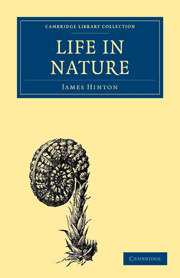Book contents
- Frontmatter
- Contents
- INTRODUCTION
- CHAPTER I OF FUNCTION; OR, HOW WE ACT
- CHAPTER II OF NUTRITION; OR, WHY WE GROW
- CHAPTER III OF NUTRITION; THE VITAL FORCE
- CHAPTER IV OF LIVING FORMS; OR, MORPHOLOGY
- CHAPTER V OF LIVING FORMS; THE LAW OF FORM
- CHAPTER VI IS LIFE: UNIVERSAL?
- CHAPTER VII THE LIVING WORLD
- CHAPTER VIII NATURE AND MAN
- CHAPTER IX THE PHENOMENAL AND THE TRUE
- CHAPTER X FORCE
- CHAPTER XI THE ORGANIC AND THE INORGANIC
- CHAPTER XII THE LIFE OF MAN
- CHAPTER XIII CONCLUSION
- APPENDIX: AN ATTEMPT TOWARDS A MORE EXTENDED INDUCTION OF THE LAWS OF LIFE
APPENDIX: AN ATTEMPT TOWARDS A MORE EXTENDED INDUCTION OF THE LAWS OF LIFE
Published online by Cambridge University Press: 29 August 2010
- Frontmatter
- Contents
- INTRODUCTION
- CHAPTER I OF FUNCTION; OR, HOW WE ACT
- CHAPTER II OF NUTRITION; OR, WHY WE GROW
- CHAPTER III OF NUTRITION; THE VITAL FORCE
- CHAPTER IV OF LIVING FORMS; OR, MORPHOLOGY
- CHAPTER V OF LIVING FORMS; THE LAW OF FORM
- CHAPTER VI IS LIFE: UNIVERSAL?
- CHAPTER VII THE LIVING WORLD
- CHAPTER VIII NATURE AND MAN
- CHAPTER IX THE PHENOMENAL AND THE TRUE
- CHAPTER X FORCE
- CHAPTER XI THE ORGANIC AND THE INORGANIC
- CHAPTER XII THE LIFE OF MAN
- CHAPTER XIII CONCLUSION
- APPENDIX: AN ATTEMPT TOWARDS A MORE EXTENDED INDUCTION OF THE LAWS OF LIFE
Summary
The motion of a pendulum consists of two portions—a downward movement caused by gravitation, and an upward movement, theoretically equal in amount, which is produced by the momentum arising from the former. The essential condition of the sequence of the upward movement is that the downward movement should be resisted in a definite manner. The gravitating motion, not being completed, becomes a motion opposed to gravity.
The molecular changes recognized in living bodies are of two kinds—those which result in that arrangement of the particles which constitutes organic matter, and those which tend to reduce organic matter to the condition of inorganic compounds. The former of these motions (or forms of action) is known as nutrition, the latter as decomposition.
It is sometimes said that decomposition results from the operation of chemical affinity, and that nutrition is the operation of the vital force, I shall for the present use these words with these meanings. If the idea of a resistance to the motion of decomposition be introduced, it may readily be conceived that the chemical and vital actions (as above defined) bear to each other the same relation as that which exists between the downward and upward motions of a pendulum. The chemical motion, not being completed, may become a motion opposed to chemical attraction.
- Type
- Chapter
- Information
- Life in Nature , pp. 229 - 258Publisher: Cambridge University PressPrint publication year: 2009First published in: 1862



